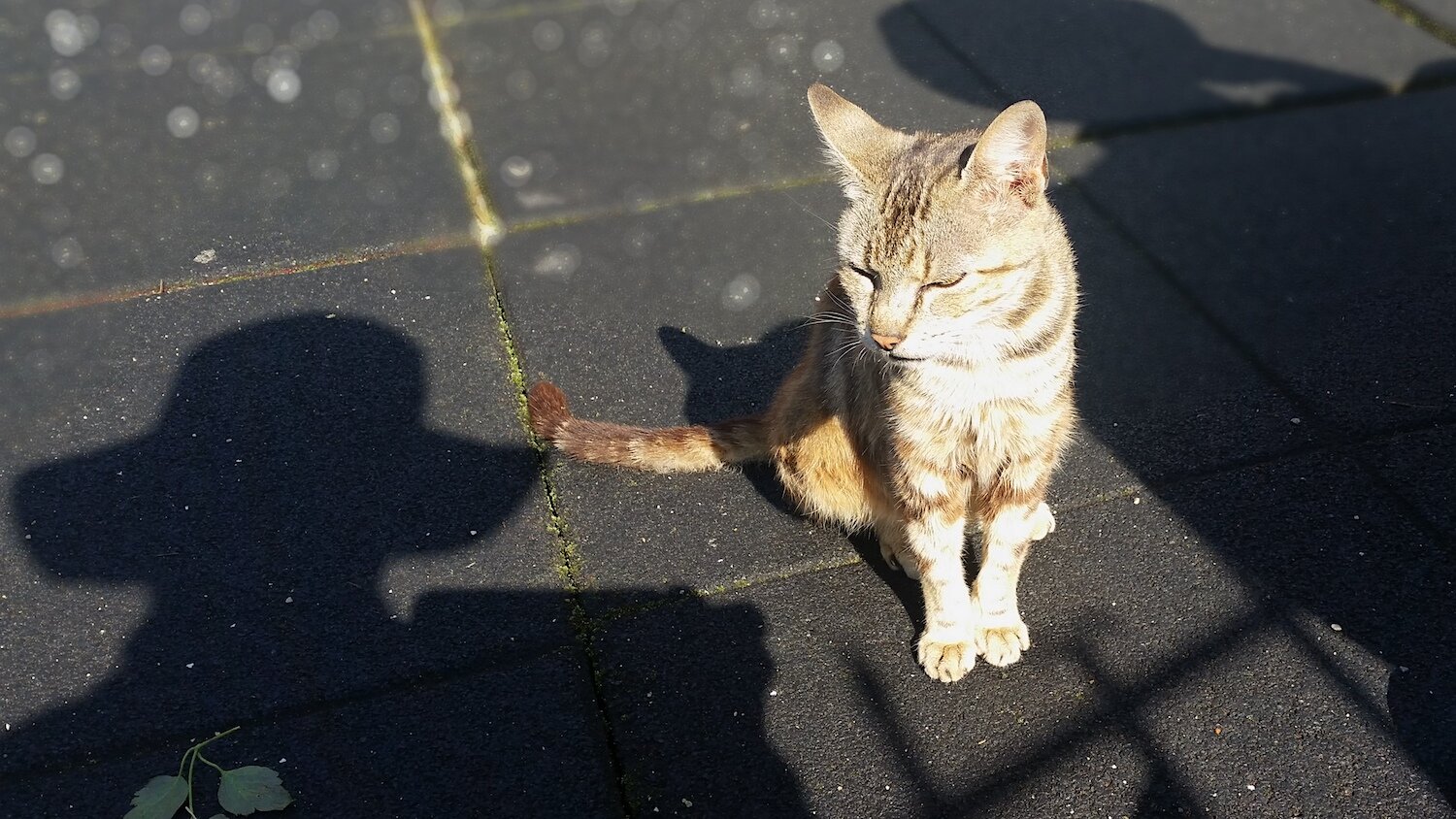Approaching Burguete in the morning hours.
We arose and followed the forested trail into a tidy town. It was known as Burguete, or Auritz in the Basque tongue. The sun was also rising. Most everyone else was slumbering though, save a small cat that offered Bob and me a generous welcome. This self-appointed mayor circled, arched, and rubbed in as cats often do when the air is full of breakfast.
The mayor of Burguete.
Burguete is a skinny place with few side streets. Two rows of whitewashed buildings leaned into the asphalt ribbon that wound up from Pamplona to Roncesvalles and trailed into the mountains. Behind us was the end of France. In front of us, the doors were closed and the windows were shuttered. Mist hung from the trees and the shadows were heavy. It was morning and we were in Spain.
“I hope we can find some coffee,” I said to Bob. “I can start a day without food if I have to, but not without coffee.”
Spain slowly grips the morning.
Our route turned sharply off the asphalt. We ignored the blaze, hoping to find a cafe or a bar. The choice was soon rewarded by the sight of walking sticks leaning against a wall. Light and conversation spilled out the open door of a small mamá- and papá-establishment. Papá stood behind the counter. His English was good enough and we asked for coffee and some of the warmed snacks on display. Those little snacks were our introduction to Spanish tapas or pinchos (pintxos in Basque). These ready-made bread-meat-onion-garlic-tomato-olive-cheese-potato combos along with a cup of coffee became our first breakfast (and sometimes our second!) from one end of Spain to the other.*
The tapas come in endless variety.
Refreshed, we retraced our steps through Burguete. We had one more place to visit before leaving town.
It was an old whitewashed farmhouse, not unlike others along the street. But this one had been converted into a hostel, a relatively inexpensive and social lodge, common in Europe. Later it was upgraded to a hotel.
The story is told that the Hostal Burguete was a favorite of American author Ernest Hemingway. An avid fisherman, he came to the region for mountain streams and trout. Our guidebook** even identified a piano in the lobby where he (reportedly) carved his name with a penknife: “E. Hemingway 25-7-1923” may be found under the top lid. I was anxious to see this inscribed piano for myself.
Hostel Burguete. Buildings in Zubiri have steep roofs to handle the winter snows.
Of course, when Bob and I found the hostel, it was shut up tight.*** But we did get the picture. And later, I dug out Hemingway’s description of the place as he incorporated it into his novel, The Sun Also Rises (1926). A piano is also featured in his story, as characters Jake Barnes and Bill Gordon arrive at the Hostel Burguete on “an awful cold” day:
“The wind was blowing against the shutters. The room was on the north side of the inn. We washed, put on sweaters, and came down-stairs into the dining-room. It had a stone floor, low ceiling, and was oak-paneled. The shutters were up and it was so cold you could see your breath.
‘My God!’ said Bill. ‘It can’t be this cold to-morrow. I’m not going to wade a stream in this weather.’
There was an upright piano in the far corner of the room beyond the wooden tables and Bill went over and started to play.
‘I got to keep warm,’ he said.”
A young Ernest Hemingway. He lodged in Burguete in 1923, the same year this passport photo was taken. Image from here (accessed 9/7/2021).
This first edition of The Sun Also Rises was published in 1926 by Scribner’s. Image from here (accessed 9/7/2021).
The sun continued to rise. Since Bob and I still had some distance to cover, we returned to the trail. A small bridge led out of town. The water gurgled underfoot. I peered down hoping to spot a trout in the shadows. “Still sleeping,” I thought.
¡Buen Camino!
We didn’t see any trout, but did enjoy the sight of this burly draft horse on our way out of Burguete. Strong horses and fighting bulls are raised in this region.
*For our foodie readers, a list of the 50 best Spanish tapas is worth pondering. See the link to recipes here (accessed 8/7/2021).
**This, and so many other details, we learned from John Brierley, A Pilgrim’s Guide to the Camino de Santiago: St. Jean Pied de Port to Santiago de Compostela (6th edition). Findhorn Press, 2010.
***For the experience of one who did see the piano and captured a photograph of the inscription, see the blog here (accessed 9/7/2021).
Join Mark and Vicki for a Mediterranean experience May 25-June 5, 2022. We'll be cruising aboard the luxurious Celebrity Infinity. See the link here for details. Onboard lectures will provide focus for the group as we visit the ports of Olympia, Santorini, Ephesus, and Athens among others. Optional add-on visits to Venice or Rome are possible on either end of the trip. Questions? Contact me at markziese@gmail.com.








